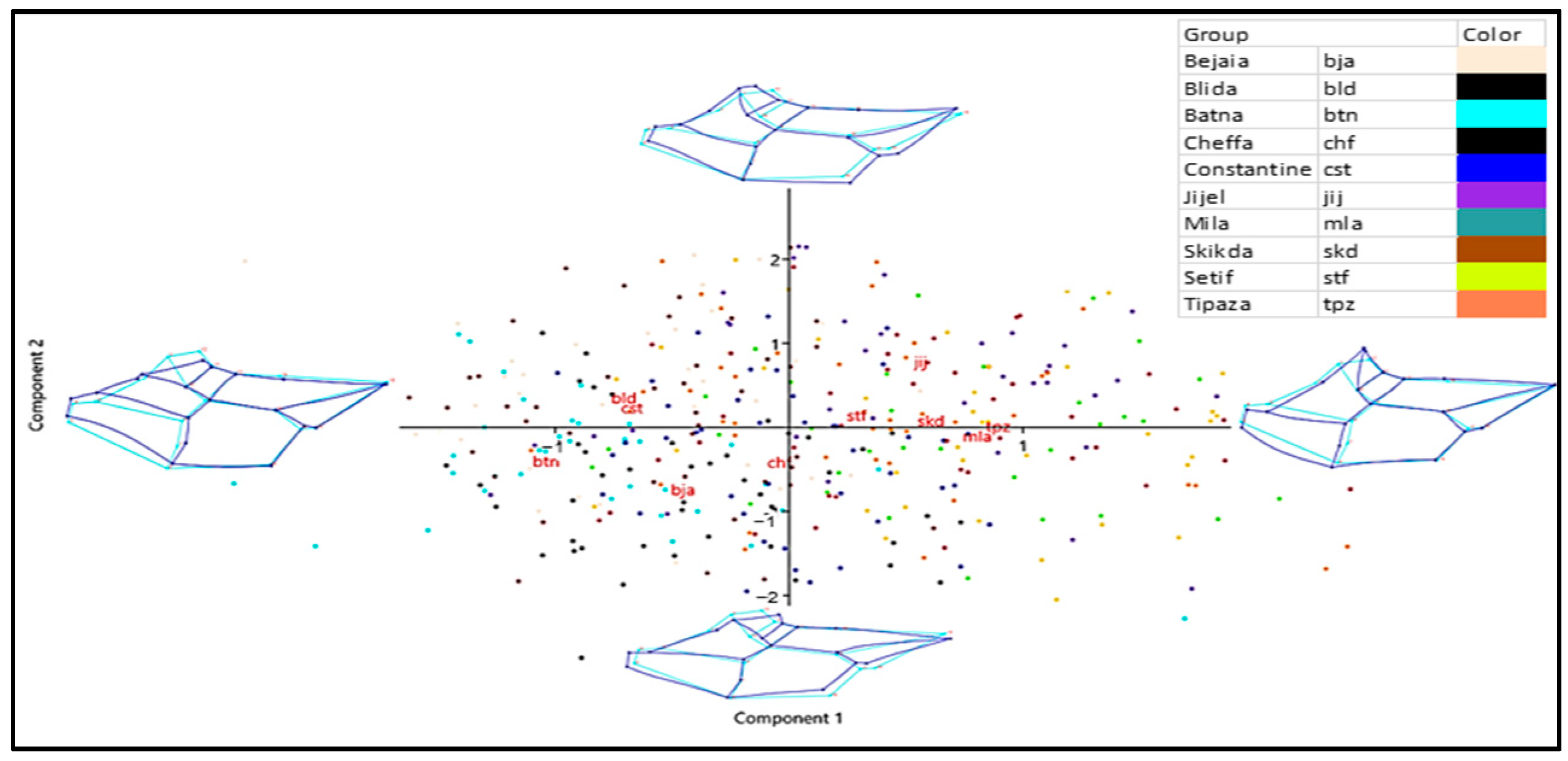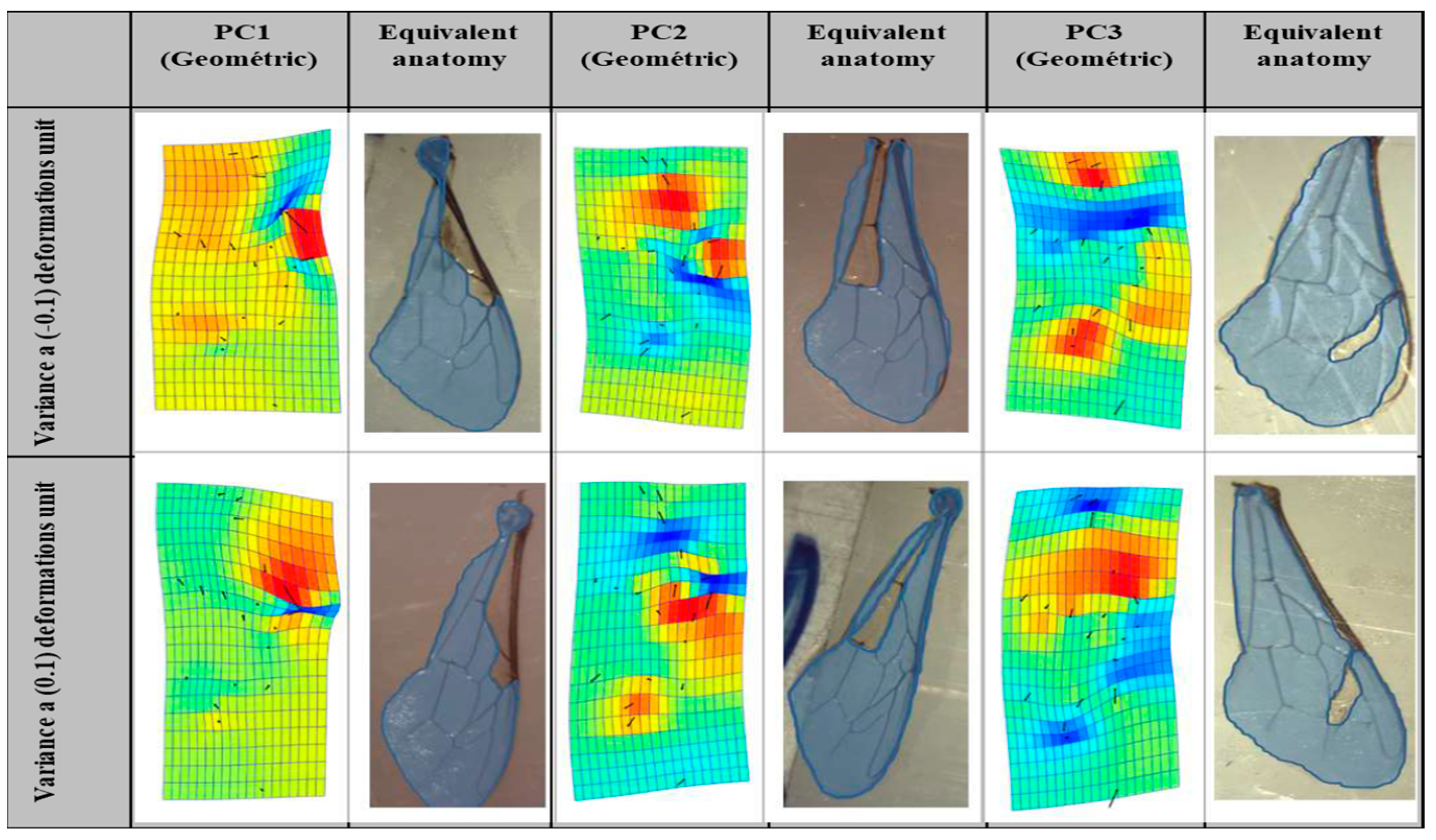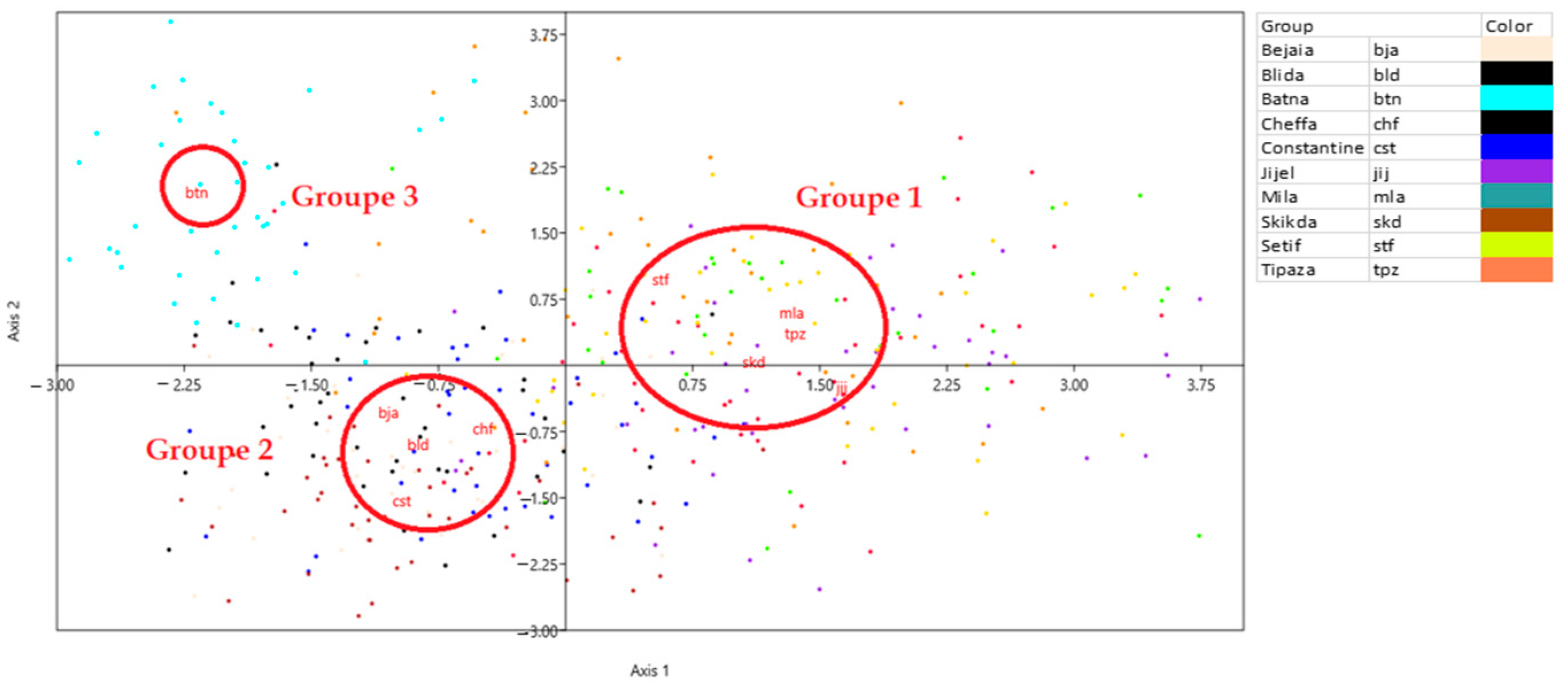Geometric Morphometric Characterization of Isolated Colonies of Honeybees (Apis mellifera intermissa) in Northern Algeria †
Abstract
:1. Introduction
2. Materials and Methods
Geo-Morphometry Approach
3. Results
Global Trends in Wing Shape
4. Discussion
Author Contributions
Funding
Institutional Review Board Statement
Informed Consent Statement
Data Availability Statement
Conflicts of Interest
References
- Linnæus, C. Systema Naturae per Regna Tria Naturae, Secundum Classes, Ordines, Genera, Species, cum Characteribus, Differentiis, Synonymis, Locis; Laurentius Salvius: Stockholm, Sweden, 1758; Volume I-II, pp. 1–824. [Google Scholar]
- Buttel-Reepen, H.V. Apistica Beitrage zur Systematik, Biologie, sowie zurgeschichtlichen und geographischen Verbreitung der Honigbiene (Apis mellifera L.), ihrer Varietaten und der ilbrigen Apis-Arten. Mitteilungen aus dem Zoologischen Museum im Berlin 1906, 3, 121–196. [Google Scholar]
- Meixner, M.D.; Pinto, M.A.; Bouga, M.; Kryger, P.; Ivanova, E.; Fuchs, S. Standard methods for characterising subspecies and ecotypes of Apis mellifera. J. Apic. Res. 2013, 52, 1–28. [Google Scholar] [CrossRef]
- De La Rúa, P.; Jaffé, R.; Dall’olio, R.; Muñoz, I.; Serrano, J. Biodiversity, conservation and current threats to European honeybees. Apidologie 2009, 40, 263–284. [Google Scholar] [CrossRef]
- Meixner, M.D.; Costa, C.; Kryger, P.; Hatjina, F.; Bouga, M.; Ivanova, E.; Büchler, R. Conserving diversity and vitality for honey bee breeding. J. Apic. Res. 2010, 49, 85–92. [Google Scholar] [CrossRef]
- Mitteroecker, P.; Gunz, P. Advances in geometric Morphometrics. Evol. Biol. 2009, 36, 235–247. [Google Scholar] [CrossRef]
- Rohlf, J.F.; Marcus, L.F. A revolution morphometrics. Trends Ecol. Evol. 1993, 8, 129–132. [Google Scholar] [CrossRef] [PubMed]
- Kendall, D.G.; Barden, D.; Carne, T.K.; Le, H. Shape and Shape Theory; John Wiley & Sons: Chichester, UK, 1999. [Google Scholar]
- Barour, C. Analyse de la Biodiversité des Populations d′Abeilles Mellifères Apis mellifera intermissa (Buttel-Reepen, 1906) (Hymenoptera: Apidea) dans le Nord Algérien: Morphométrie Moderne Basée sur la Configuration des Points-Repères (Landmarks); Université Badji Moktar de Annaba (UBMA): Annaba, Algeria, 2012. [Google Scholar]
- Bookstein, F.L. Morphometric Tools for Land-Mark Data: Geometry and Biology; Cambridge University Press: Cambridge, UK, 1991. [Google Scholar]
- Zelditch, M.L.; Swiderski, D.L.; Sheets, H.D.; Fink, W.L. Geometric Morphometrics for Biologists: Aprimer; Elsevier Academic Presss: London, UK, 2004. [Google Scholar]
- Adjlane, N.; Doumandji, S.E.; Haddad, N. Situation de l’apiculture en Algérie: Facteurs menaçant la survie des colonies d’abeilles locales Apis mellifera intermissa. Cah. Agric. 2012, 21, 235–241. [Google Scholar] [CrossRef]
- Barour, C.; Tahar, A.; Baylac, M. Forewing shape variation in Algerian honey bee populations of Apis mellifera intermissa (Buttel-Reepen, 1906) (Hymenoptera: Apidae): A landmark-based geometric morphometrics analysis. Afr. Entomol. 2011, 19, 11–22. [Google Scholar] [CrossRef]
- Rohlf, F.J. TpsDig Version 2.12 (Tps_Digitize); Stony Brook; State University of New York: New York, NY, USA, 2008. [Google Scholar]
- Ihaka, R.; Gentleman, R. A language for data analysis graphics. Comput. Graph. Stat. 1996, 5, 299–314. [Google Scholar] [CrossRef]
- Klingenberg, C.P. MorphoJ: An integrated software package for geometric morphometrics. Mol. Ecol. Resour. 2011, 11, 353–357. [Google Scholar] [CrossRef] [PubMed]
- Mardia, K.V.; Kent, J.T.; Bibby, J.M. Multivariate Analysis; Academic Press: London, UK, 1979. [Google Scholar]
- Kandemir, İ.; Özkan, A.; Fuchs, S. Reevaluation of honeybee (Apismellifera) microtaxonomy: A geometric morphometric approach. Apidologie 2011, 42, 618–627. [Google Scholar] [CrossRef]
- Rattanawannee, A.; Chanchao, C.; Wongsiri, S. Gender and Species Identification of Four Native Honey Bees (Apidae: Apis) in Thailand Based on Wing Morphometic Analysis. Ann. Entomol. Soc. Am. 2010, 103, 965–970. [Google Scholar] [CrossRef]
- Ruttner, F.; Tassencourt, L.; Louveaux, J. Biometrical statistical analysis of the geographic variability of Apis mellifera L. LI Material and methods. Apidologie 1978, 9, 363–381. [Google Scholar] [CrossRef]
- Barour, C.; Tahar, A.; Radloff, S.; Hepburn, H. Multivariate analysis of honey bees, Apis mellifera Linnaeus (Hymenoptera: Apidae) of the northeastern and southern regions of Algeria. Afr. Entomol. 2005, 13, 17–23. [Google Scholar]



| Locality | Altitude (m) | Latitude | Longitude | Bioclimat | Country | Temperature (°C) |
|---|---|---|---|---|---|---|
| Bejaia | 298 | 36.3419 | 4.5635 | Humid | Algeria | 16.9 |
| Blida | 114 | 36.3153 | 2.5546 | Sub-humid | Algeria | 17.1 |
| Jijel | 74 | 36.4104 | 6.1628 | Humid | Algeria | 18.1 |
| Mila | 753 | 36.2116 | 5.5138 | Sub-humid | Algeria | 14.5 |
| Setif | 955 | 35.4913 | 5.3026 | Semi-arid | Algeria | 14 |
| Skikda | 236 | 36.5324 | 7.0532 | Humid | Algeria | 17.2 |
| Tipaza | 186 | 36.2805 | 2.261 | Sub-humid | Algeria | 18 |
| Constantine | 640 | 36.3613 | 6.6296 | Sub-humid | Algeria | 15.6 |
| Batna | 1048 | 35.5527 | 6.1506 | Semi-arid | Algeria | 13.5 |
| Bejaia | Blida | Batna | Cheffa | Constantine | Jijel | Mila | Skikda | Sétif | |
|---|---|---|---|---|---|---|---|---|---|
| Bejaia | 2.26 | ||||||||
| Batna | 3.12 | 3.17 | |||||||
| Cheffa | 2.66 | 2.50 | 3.51 | ||||||
| Constantine | 2.45 | 1.86 | 3.66 | 2.32 | |||||
| Jijel | 3.43 | 3.05 | 4.29 | 3.11 | 3.28 | ||||
| Mila | 3.42 | 3.50 | 4.10 | 3.35 | 3.55 | 2.80 | |||
| Skikda | 2.75 | 2.89 | 3.90 | 2.70 | 2.96 | 1.91 | 1.78 | ||
| Sétif | 2.81 | 2.80 | 3.00 | 2.74 | 3.16 | 1.98 | 2.31 | 1.90 | |
| Tipaza | 3.51 | 2.98 | 3.95 | 2.83 | 3.43 | 2.13 | 2.62 | 2.26 | 2.02 |
Disclaimer/Publisher’s Note: The statements, opinions and data contained in all publications are solely those of the individual author(s) and contributor(s) and not of MDPI and/or the editor(s). MDPI and/or the editor(s) disclaim responsibility for any injury to people or property resulting from any ideas, methods, instructions or products referred to in the content. |
© 2024 by the authors. Licensee MDPI, Basel, Switzerland. This article is an open access article distributed under the terms and conditions of the Creative Commons Attribution (CC BY) license (https://creativecommons.org/licenses/by/4.0/).
Share and Cite
Khedim, R.; Mediouni, R.M.; Gaouar, S.B.S. Geometric Morphometric Characterization of Isolated Colonies of Honeybees (Apis mellifera intermissa) in Northern Algeria. Biol. Life Sci. Forum 2024, 36, 9. https://doi.org/10.3390/blsf2024036009
Khedim R, Mediouni RM, Gaouar SBS. Geometric Morphometric Characterization of Isolated Colonies of Honeybees (Apis mellifera intermissa) in Northern Algeria. Biology and Life Sciences Forum. 2024; 36(1):9. https://doi.org/10.3390/blsf2024036009
Chicago/Turabian StyleKhedim, Radjaa, Rida Mohammed Mediouni, and Semir Bechir Suheil Gaouar. 2024. "Geometric Morphometric Characterization of Isolated Colonies of Honeybees (Apis mellifera intermissa) in Northern Algeria" Biology and Life Sciences Forum 36, no. 1: 9. https://doi.org/10.3390/blsf2024036009
APA StyleKhedim, R., Mediouni, R. M., & Gaouar, S. B. S. (2024). Geometric Morphometric Characterization of Isolated Colonies of Honeybees (Apis mellifera intermissa) in Northern Algeria. Biology and Life Sciences Forum, 36(1), 9. https://doi.org/10.3390/blsf2024036009






